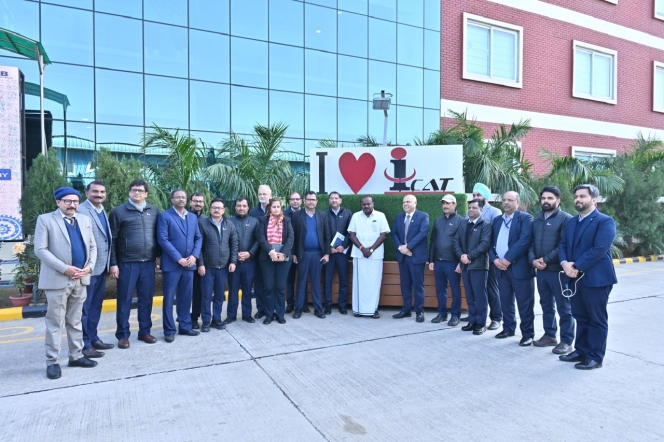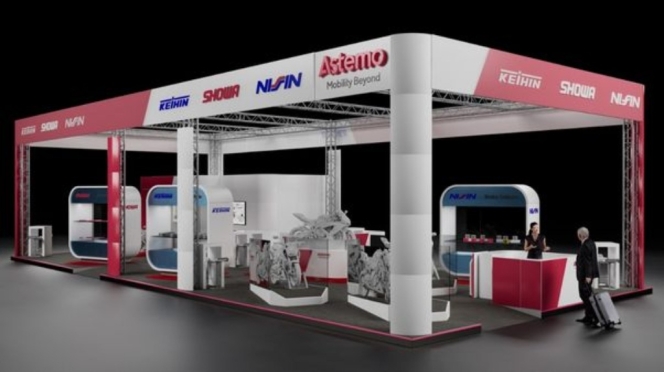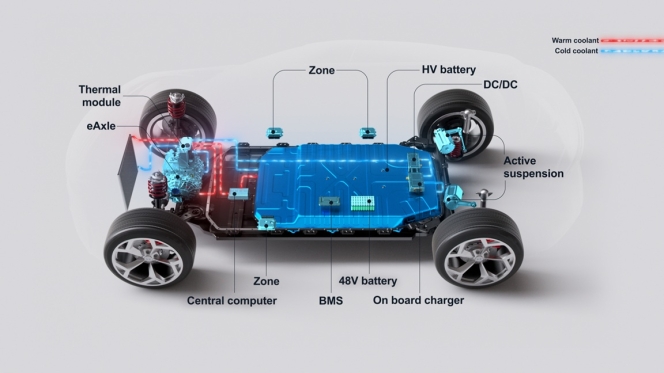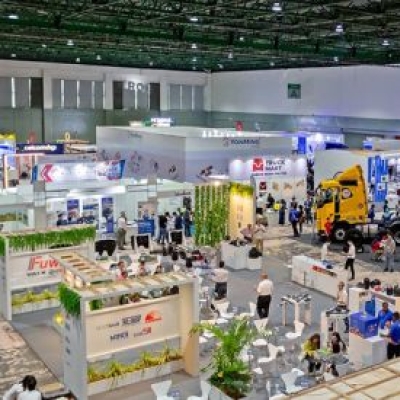- Union Minister for Heavy Industries
- International Centre for Automotive Technology
- ICAT
- Automotive innovation
Union Minister Applauds ICAT's Advanced Testing and Research Facilities
- By MT Bureau
- January 21, 2025

Union Minister for Heavy Industries, HD Kumaraswamy, visited the International Centre for Automotive Technology (ICAT) in Manesar today. During his visit, the minister toured the state-of-the-art facility, which is a testament to India’s growing prowess in automotive innovation and safety standards.
The minister was given an in-depth overview of ICAT’s advanced laboratories, testing tracks and cutting-edge technologies including crash tests, acoustic rooms for reverberation studies and fuel flow testing mechanisms.
During his visit, he laid the foundation stone of Electrical and Electrical Lab and Centre of Excellence for Advanced Automotive IT Services (AAITS) in the presence ICAT Director Saurabh Dalela and other senior officials.
Speaking to the media after the visit, Kumaraswamy said, “It is my pleasure to be here on my first visit to ICAT, an institution that represents India's drive towards automotive excellence. ICAT’s state-of-the-art facilities, including its advanced laboratories and testing infrastructure, are a testament to India’s capabilities in automotive innovation.”
The minister highlighted the crucial role ICAT plays in ensuring road safety through rigorous testing procedures. “Witnessing these facilities and tests today has given me a profound perspective on the rigorous efforts undertaken here to ensure the safety of every individual who travels on our roads. It showcases the complexity and commitment behind each test,” he added.
Kumaraswamy commended the ICAT team for their invaluable contributions to the automotive sector, emphasizing their role in advancing sustainability, safety, and innovation. “ICAT is not just a testing and research facility; it embodies the shared vision of the ministry and the government to drive the future of mobility in India,” he said.
The minister also noted ICAT’s significant contributions to government initiatives such as the FAME scheme, PM eDrive, and the Production Linked Incentive (PLI) scheme. He underlined the importance of ICAT’s involvement in promoting indigenous manufacturing and global competitiveness in the automotive sector.
“ICAT stands as a symbol of India’s automotive aspirations, contributing significantly to our transition to electric mobility and sustainable transportation. The Ministry of Heavy Industries remains committed to supporting ICAT in every possible way to ensure its continued growth and success,” Kumaraswamy assured.
The Indian automotive industry, which contributes over 7 percent to the nation’s GDP and employs millions, is expected to witness robust growth in the coming years. The minister emphasized that ICAT’s technical expertise, research and homologation services would play a pivotal role in ensuring that this growth is sustainable, safe, and competitive on a global scale.
Concluding his visit, Kumaraswamy reaffirmed the Ministry of Heavy Industries’ commitment to fostering innovation, creating policy frameworks, and building infrastructure to position India as a global leader in automotive technology.
“Together, we can make India a global leader in automotive technology and innovation, ensuring safer, better vehicles for Indian and global customers alike,” he said.
Honda Increases Stake In Astemo To Drive Software Development
- By MT Bureau
- December 17, 2025

Honda Motor Co., and Hitachi have signed an agreement for Hitachi to transfer a portion of its common shares in automotive component supplier Astemo to Honda.
The transaction shifts the voting rights of the joint venture. Previously held at a 40–40 percent split between Honda and Hitachi, with 20 percent held by JICC-01, the new structure grants Honda a 61 percent majority stake. Hitachi’s share will decrease to 19 percent, while JICC-01 maintains its 20 percent holding.
The capital restructure aims to position Astemo as a provider of integrated vehicle systems for the Software Defined Vehicle (SDV) era. The company intends to integrate software and hardware across in-car domains and cloud engineering.
Under the new arrangement, Astemo will increase collaboration with Honda to utilise the automaker’s development expertise. Hitachi will continue to provide support focused on digital technology to assist in AI and software development.
The company confirmed its intent to pursue an Initial Public Offering (IPO) while focusing on the electrification of mobility and AI-driven intelligence.
"Under the new capital structure, Astemo will accelerate its efforts more than ever, aiming to become a company that leads the electrification of mobility and AI-driven intelligence in the SDV age. As a system solution provider that offers not just individual components but software-defined integrated vehicle systems, Astemo aims to be a leading company that drives electrification and AI-driven intelligence of mobility in the SDV age, challenging itself to achieve further growth," said Astemo in a statement.
At present, Astemo has over 80,000 employees globally and operates across the Americas, Asia, Europe and Japan, managing divisions for electrification, vehicles and motorcycles.
ACMA Mobility Foundation And Spark Minda Host Technology Showcase
- By MT Bureau
- December 17, 2025
The ACMA Mobility Foundation and Spark Minda Group recently held the Spark Connect Tech Show, which aimed to increase visibility and capability development for Tier-2 and Tier-3 suppliers within the automotive supply chain.
The initiative involved 25 supplier partners representing a shift in ACMA’s technology engagement, moving from OEM-led events to Tier-1-hosted platforms. This format allowed suppliers to present solutions directly to Tier-1 and OEM functions.
Vinnie Mehta, Director General, ACMA, stated, “While ACMA organises several large exhibitions and international events, targeted technology shows such as these play a distinct role in supporting individual companies. They enable direct engagement between OEMs, Tier-1s and supplier partners, and provide valuable, specific feedback from engineering, R&D and procurement teams. This kind of engagement is critical as we work to strengthen Tier-2 capabilities and build a more competitive automotive ecosystem.”
Aakash Minda, Executive Director, Spark Minda Group and Chairperson, Supply Chain & Raw Materials Pillar, ACMA, added, “Through our collaboration with the ACMA Mobility Foundation on initiatives such as the Spark Connect Tech Show, we are working to improve visibility and access for Tier-2 and Tier-3 supplier partners across Tier-1s and OEMs. These buyer-seller engagements provide an opportunity for suppliers to showcase their capabilities and explore potential collaboration and business opportunities within the automotive value chain.”
The Spark Connect Tech Show is part of the ACMA Mobility Foundation’s work to deepen supply-chain integration. The foundation focuses on the development of the automotive components ecosystem.
- ZF Group
- EXCON 2025
- ERGOPOWER Powershift Transmission
- ECOMIX I Hydrostatic Drum Drive
- MULTITRAC Axles
ZF Group to Present Vision For Future Of Construction At EXCON 2025
- By MT Bureau
- December 09, 2025
ZF Group will present its vision for the future of construction at EXCON 2025, highlighting how localised manufacturing and intelligent technologies meet the industry's demand for rapid development and operational flexibility. This vision is anchored by the company's new state-of-the-art plant in Coimbatore, a EUR-20-million facility dedicated to producing transmissions and axles under a ‘local for local’ strategy. This investment strengthens ZF's commitment to India, enabling it to deliver world-class, innovative solutions for both domestic and international markets from within the region.
The company's exhibit will demonstrate integrated systems engineered for greater productivity and sustainability. Key among these is the ERGOPOWER powershift transmission for wheel loaders, designed to achieve up to 15 percent fuel savings and up to 40 percent gains in productivity. It is complemented by the durable MULTITRAC axles, which feature a compact design and efficient wet multi-disc brakes for heavy-duty applications. This combined driveline solution also empowers backhoe loaders, providing the robust performance needed for intense digging and loading cycles.
For mixer trucks, ZF offers the ECOMIX I hydrostatic drum drive, a compact and rugged system known for high reliability, easy installation and a long service life. Beyond driveline components, ZF is advancing vehicle control with its latest brake-by-wire technology. This system represents a significant shift by using electronic signals to manage deceleration, eliminating the need for hydraulic lines in the cab. This innovation is a foundational step towards enabling future remote and autonomous operation for off-highway machinery.
Through these targeted solutions and its strategic manufacturing footprint, ZF Group positions itself as a pivotal partner in building efficient, high-performance and increasingly automated construction equipment.
Akash Passey, President, ZF Group India, said, “At ZF Group, we’re proud to deepen our commitment to India’s dynamic construction sector by expanding local production of transmissions and axles in the recently inaugurated plant at Coimbatore. This strategic investment aligns with the Group’s ambition for the region and is aligned with the Government of India’s ambitious infrastructure push. Our advanced product portfolio is designed for unwavering reliability and is in step with the market trends towards cleaner, smarter and digitally enabled machines.”
Marelli Unveils Intelligent Energy Management System For Hybrid And EVs At CTI Symposium
- By MT Bureau
- December 03, 2025

Marelli, a global mobility technology supplier, unveiled its new solution for Intelligent Energy Management for hybrid and electric vehicles at CTI Europe 2025 in Berlin, Germany.
The modular system is based on proprietary software that can be integrated with vehicle and zonal control units and thermal components. This holistic approach coordinates seamlessly across the vehicle’s three main energy domains: thermal, propulsion and electronics. This maximises efficiency across all vehicle systems, delivering enhanced battery range, optimised fast charging and improved longevity, all while maintaining cabin comfort and operational reliability.
Marelli's new Intelligent Energy Management system is aimed at advancing both hybrid and electric propulsion solutions, as well as Software-Defined Vehicle (SDV) technologies.
The system was developed by integrating advanced digital twin methodologies and software strategies. This approach significantly reduces development time and costs while enabling collaboration with customers.
Thermal Domain: The system manages and optimises thermal flows, ensuring precise control of heating and cooling processes within the vehicle. Algorithms intelligently manage complex thermal systems, regulating temperatures to optimise overall performance and extend battery life. These strategies reduce energy losses and promote reuse of excess thermal energy.
Electric/Hybrid Propulsion: The system continuously monitors and adjusts power delivery to optimise energy distribution. This maximises battery efficiency and vehicle performance. By recovering energy and balancing its distribution, the system extends driving range and enhances resilience.
Electronics Domain: The solution enhances the intelligence and integration of vehicle systems by facilitating seamless communication between all components and systems. Data exchanges occur over communication protocols – from CAN to Ethernet – enabling direct management of sensors and actuators.
The development of a digital twin application allows for virtual modelling of every vehicle subsystem, including electronics, electromechanics, thermodynamics, and hydraulics. By creating virtualised car models, automakers can iterate faster and test more efficiently.
Giovanni Mastrangelo, Head of R&D for Marelli's Propulsion business, said, "Intelligent energy management is the central challenge facing today’s electric and hybrid vehicle development. At Marelli, we address this by delivering solutions that not only optimise energy flow across thermal, electric and propulsion domains, but also minimise losses and recover excess thermal energy. Through our digital twin and decoupled software approach, we empower our customers to reduce development timelines, gain flexibility and accelerate adoption of cutting-edge technologies, driving the future of sustainable and efficient mobility."






Comments (0)
ADD COMMENT